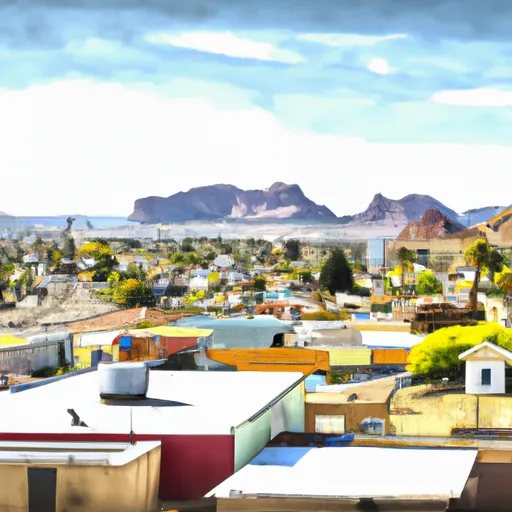-
 Snoflo Premium
Snoflo Premium
Get unlimited access to all our content
With no Ad interruptions! - Start Your Free Trial Login with existing account
Kingman
Eden Index
Climate
8.9
•
Recreation
4.6
•
Community
1.4
•
Safeguard
5.5/10

Kingman, Arizona is a vibrant city located in Mohave County, nestled between the Hualapai and Cerbat Mountains. It experiences a desert climate, characterized by hot summers and mild winters. Summers are scorching, with temperatures often exceeding 100°F (38°C), while winters are cooler, averaging in the mid-50s°F (10-15°C). Precipitation is minimal, with an average of 8 inches (20 cm) annually.
Hydrologically, Kingman benefits from its proximity to the Colorado River, which provides a vital water source for the region. Additionally, the city is situated near reservoirs such as Lake Mead and Lake Mohave, offering opportunities for various water activities like boating, fishing, and swimming.
As for outdoor recreation, Kingman boasts a range of options. Hikers and nature enthusiasts can explore the stunning trails in the Hualapai and Cerbat Mountains, enjoying breathtaking views of the surrounding desert landscapes. The area is also known for its off-roading opportunities, with numerous trails for ATV and dirt bike enthusiasts. Kingman is home to several parks and golf courses, providing ample options for relaxation and sporting activities. Overall, Kingman offers a diverse range of outdoor recreation opportunities for visitors and residents alike.
What is the Eden Index?
The Snoflo Eden Index serves as a comprehensive rating system for regions, evaluating their desirability through a holistic assessment of climate health, outdoor recreation opportunities, and natural disaster risk, acknowledging the profound impact of these factors on livability and well-being.
Climate Health Indicator (CHI): 8.9
Kingman receives approximately
246mm of rain per year,
with humidity levels near 62%
and air temperatures averaging around
17°C.
Kingman has a plant hardyness factor of
8, meaning
plants and agriculture in this region tend to thrive here all year round.
By considering the ideal temperature range, reliable water supplies, clean air, and stable seasonal rain or snowpacks, the Climate Health Indicator (CHI) underscores the significance of a healthy climate as the foundation for quality living.
A healthy climate is paramount for ensuring a high quality of life and livability in a region, fostering both physical well-being and environmental harmony. This can be characterized by ideal temperatures, reliable access to water supplies, clean air, and consistent seasonal rain or snowpacks.
Weather Forecast
Streamflow Conditions
Lower Colorado-Lake Mead
Area Rivers
Lower Colorado-Lake Mead
Snowpack Depths
Lower Colorado-Lake Mead
Reservoir Storage Capacity
Lower Colorado-Lake Mead
Groundwater Levels
Recreational Opportunity Index (ROI): 4.6
The Recreational Opportunity Index (ROI) recognizes the value of outdoor recreational options, such as parks, hiking trails, camping sites, and fishing spots, while acknowledging that climate plays a pivotal role in ensuring the comfort and consistency of these experiences.
Access to outdoor recreational opportunities, encompassing activities such as parks, hiking, camping, and fishing, is crucial for overall well-being, and the climate plays a pivotal role in enabling and enhancing these experiences, ensuring that individuals can engage in nature-based activities comfortably and consistently.
Camping Areas
| Campground | Campsites | Reservations | Toilets | Showers | Elevation |
|---|---|---|---|---|---|
| Windy Point | 7 | 6,116 ft | |||
| Hualapai Mountain Park | 70 | 6,364 ft | |||
| Wild Cow Springs | 24 | 6,201 ft |
Nearby Ski Areas
Catastrophe Safeguard Index (CSI):
The Catastrophe Safeguard Index (CSI) recognizes that natural disaster risk, encompassing floods, fires, hurricanes, and tornadoes, can drastically affect safety and the overall appeal of an area.
The level of natural disaster risk in a region significantly affects safety and the overall livability, with climate change amplifying these risks by potentially increasing the frequency and intensity of events like floods, fires, hurricanes, and tornadoes, thereby posing substantial challenges to community resilience and well-being.
Community Resilience Indicator (CRI): 1.4
The Community Resilience Indicator (CRI) recognizes that education, healthcare, and socioeconomics are crucial to the well-being of a region. The CRI acknowledges the profound impact of these elements on residents' overall quality of life. By evaluating educational resources, healthcare accessibility, and economic inclusivity, the index captures the essential aspects that contribute to a thriving community, fostering resident satisfaction, equity, and social cohesion.

